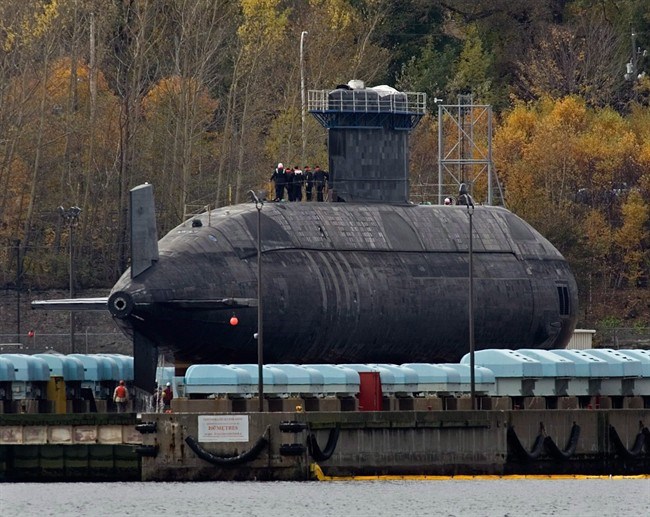For the Royal Canadian Navy’s longest-qualified submariner, Canada’s acquisition of a second-hand submarine in the early 1960s marked a milestone.
Donald Brown had already been part of the first draft of Canadians to join the Royal Navy in 1954 and trained on American submarines, when Canada leased HMCS Grilse from the U.S. navy.
“When Canada got Grilse, it showed that we were, in actual fact, growing up,” Brown said. “If you don’t have a submarine for an anti-submarine navy, it’s like playing hockey without a puck.”
Brown, who rose to the rank of chief petty officer second class before retiring in 1977, was one of several veterans who attended a rededication ceremony of the submarine memorial cairn at CFB Esquimalt on Thursday. He placed a time capsule, containing memorabilia from the 15 submarines that have served Canada, in the refurbished cairn.
The event marked 100 years since Canada purchased its first submarines — raising questions about the future of the current aging fleet.
“Personally, I would like to see a more modern type of vessel,” Brown said of today’s fleet.
Canada bought its first submarines in 1914, through clandestine negotiations initiated by then-premier Richard McBride. McBride purchased HMCS CC-1 and CC-2 from a Seattle shipyard for $1.15 million without approval from the U.S. government, as a deterrent against a German attack at the outset of the First World War. The submarines had been intended for the Chilean navy and were transported to B.C. under the cloak of darkness.
The next purchase of new submarines wouldn’t come until 1962, when the navy acquired three British Oberon-class submarines.
Meanwhile, anti-submarine warfare training was conducted using second-hand vessels — including two British H-class and two captured U-boats — as well as rentals from the Royal Navy and U.S. navy. HMCS Grilse was leased from the U.S. for seven years during the Cold War, followed by HMCS Rainbow, which was purchased in 1968 and served the West Coast until 1974.
Today, Canada has four second-hand submarines in its fleet, divided between Esquimalt and Halifax: HMCS Chicoutimi, HMCS Victoria, HMCS Windsor and HMCS Corner Brook.
Since the submarines were purchased from the British navy in 1998, the federal government has spent about $1 billion on repairs and refits. The navy has had to deal with a fatal fire, a generator defect, and a submarine that ran aground.
But according to Capt. Jamie Clarke, director of the Canadian submarine force, maintenance challenges are anticipated with any submarine.
“Submarine maintenance is a challenge for any submarine-operating nation. They will all tell you the same. The maintenance is vigorous, but when you consider the environment they operate in, that’s understood,” he said.
“I’m incredibly optimistic about the future of Canadian submarine forces. Chicoutimi will be returning to sea this fall. … We’re also being very aggressive updating equipment to make sure the submarines remain capable and relevant.”



